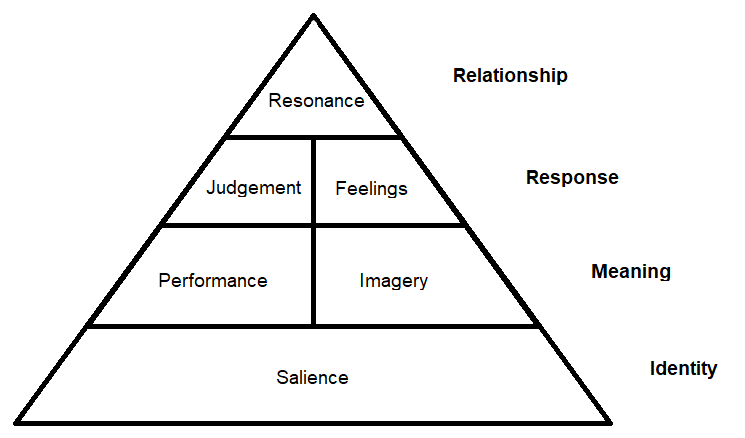Brand resonance is how well clients and customers relate to a specific brand. It is how they perceive the values and goals of that brand. It is how brands can build relationships with their target audience. Strictly speaking, when people speak of brand resonance, they refer to a “brand resonance pyramid”. This all comes from Keller’s Brand Equity Model which is also known as the Customer-Based Brand Equity Model.
The Brand Equity Model is built as a pyramid with brand resonance at the very top. Essentially, if you want to build a strong brand, this is what you should be aiming to achieve. The Brand Equity Model is a great tool for building a brand. It lays what the foundations of a strong brand are and what can be done to achieve brand resonance.
The Pyramid

The brand resonance pyramid is made up of four layers. Each layer builds upon the previous to answer a specific question about the brand that people can relate to. The very basic layer relates to a brand’s identity and answers the question “Who are you?”. Once people are able to answer that question about your brand, the brand’s meaning needs to be understood. This is the second layer of the pyramid and seeks to answer the question of “What are you?”. One step above that is the third layer. Once people know who and what your brand is, it comes time to answer how they feel or think about the brand. This is referred to as their response. Both meaning and response have a rational and emotional side to them, but we’ll get to that later. Sitting at the highest layer and the pinnacle of the pyramid, we have the relationship between the brand and the customer. This encapsulates brand resonance.
So now that we have an overview of the model and the pyramid, let’s look at each layer in detail and what could be done to strengthen specific aspects of a brand.
Identity
The first-most goal of a brand is to build salience – or awareness. Salience also includes recognition. Not only is it how well customers and clients can recognise the brand, but also how well they can recall information about the brand. The role of this layer is to make sure customers have the correct perceptions of the brand.
You may know your target market’s needs, but it’s important to also convey how the brand can fulfill those needs. The more people know about who the brand is, the more aware of it they will be.
- Define the brand clearly. Incorrect perceptions of your brand may attract the wrong market or muddy your brand with a multitude of other similar brands.
- Make sure people are always exposed to your brand. A hidden brand is an unknown one. Awareness starts with exposure.
- Get creative. The basic definition of “salience” is how well something stands out. It’s no use having brand exposure, but it’s just like every other brand.
Meaning
This layer of the pyramid may be confused with identity since who/what can be confusing when dealing with something abstract as a brand. The distinction is that meaning is given to a brand after one is already aware of it.
The rational aspect of meaning is termed “performance”. This is how well the brand fulfills the needs of the client or customer. It is a measure of the efficiency and effectiveness of the product or service. Reliability, price, and design are the core elements of this aspect. The most powerful way of getting your brand’s performance out there is through differentiation. There needs to be a reason why people should prefer your brand over others.
- Think carefully about how to best solve customers’ needs.
- Fit the service or product to the brand’s message. Congruence between the product or service and the brand is key. An environmentally aware brand should convey this in their work as well.
The emotional aspect of meaning is known as “imagery”. This is an easy one as it refers to the brand’s image. How does the brand relate to others on a social or psychological level? This relates to a customer’s experience with the brand itself, either directly or indirectly. Logos and fonts are but a small portion of brand imagery. The goal of this aspect is to invoke feelings in customers. The brand should provide meaning to the customer.
- Visual elements should fit with the brand’s message. A strong message is supported by both facts and feelings.
- Learn more about your audience on more than just a need-fulfillment level. What other factors might drive your customers towards your brand?
All of these work together to provide meaning to your brand and give it personality. From here on, the brand should feel “alive”.
Response
So now that the brand has created its message, refined its image, and made others aware of it, it remains to see the reaction of the clients or customers. These can be refined by working on the first two foundational layers, but first we need to know what the response entails.
The rational side of the response are the judgements. In essence, it’s the client or customer’s response to the performance of the brand. This is based on the brand’s quality, credibility, consideration for their needs, and standing among other brands.
- Enhance the actual or perceived quality of the product or service to better fulfill client or customer needs. The important thing is to consider how others perceive the brand.
- Improve your marketing. Focus on improving perception and communicating effectively.
Feelings are the emotional response to the brand. The model specifies six positive feelings that can be associated with a brand: warmth, fun, excitement, security, social approval, and self-respect. The brand can invoke emotions directly as per imagery, but the customers can also respond emotionally to how the brand makes them feel about themselves more than just the message.
- Which positive feelings does your marketing strategy focus on? Think about how to enhance those feelings.
- Personalise the content of the brand. It’s much easier to relate to a brand that feels like “it’s meant for me”.
Focus on building a strong, positive brand experience. These experiences will lay the groundwork for building relationships and memories with the brand and make resonating much easier.
Relationship
And finally, we arrive at the top of the pyramid. This is the part that brands should aim towards. Once awareness of a strong brand has been created and customers respond positively, retaining those customers is a very important task. In doing so, a brand should aim to build a positive relationship with the audience.
Once a deep, psychological bond has been formed with the brand, you have achieved brand resonance. Every layer below this has built towards brand resonance. The purpose of this layer is sustaining it. How can this be achieved? The model breaks brand resonance into four categories:
- Behavioural loyalty – This includes things such as repeat purchases. How can you increase loyalty? Gift cards? Customer loyalty programmes? Think about what encourages loyalty both rationally and emotionally.
- Attitudinal attachment – This is when customers and clients love your product or service. Buying from the brand is special and can be seen as the premium option.
- Sense of community – Customers should feel a sense of community with other customers and the brand itself. A strong emotional message and personalised marketing helps to create a brand that feels relatable and that one can trust to take care of them. Customer service goes a long way here.
- Active engagement – This is brand resonance and loyalty at its finest. This is when customers are actively engaged with the brand whether purchasing or not. Following the brand’s social media, attending brand events, or any activity related to the brand that isn’t inherently transactional are all examples of active engagement.
For each layer and aspect of the pyramid, ask yourself what you could do to improve on it. Each building block will support and build on the next so creating a strong foundation for the brand is a good way of achieving brand resonance. And remember that times may change, so improvise, adapt, and overcome. In this way, Keller’s Brand Equity Model can skyrocket even a meagre brand to success.











